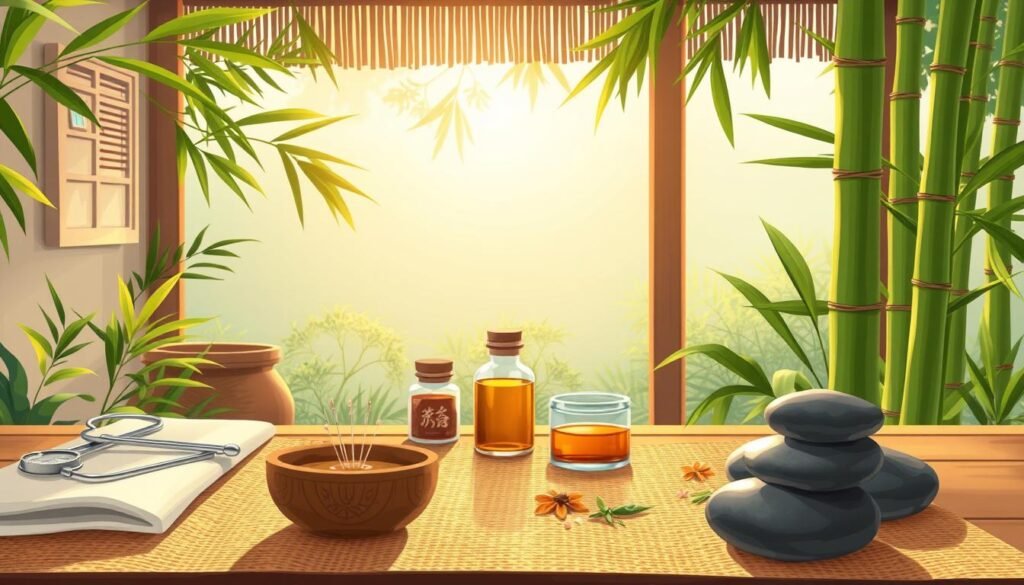In 2020, the market for alternative medicine was worth over $82 billion. Experts believe this will grow by 22.03 percent by 2028. This shows how much people are getting into alternative and natural treatments. This wellness guide shines a light on the holistic health world. It talks about different ways to improve your wellbeing outside of traditional medicine.
There are many ways to look after your body, mind, and spirit. These include acupuncture, herbal remedies, cryotherapy, and aromatherapy. As people look for other options besides regular medicine, knowing about these can help. If you want to know more about alternative medicine, check out this informative guide.
Key Takeaways
- The global market for complementary and alternative medicine is set to grow significantly, reflecting rising interest.
- Botanicals were the most widely used alternative medicines in 2020, showing the popularity of herbal remedies.
- Chiropractic care and acupuncture have gained acceptance for treating specific ailments effectively.
- Mind-body practices like yoga and mindfulness are recognized for addressing both mental and physical health.
- Naturopathy uses natural remedies to promote overall health and wellbeing.
- Aromatherapy and cryotherapy are modern treatments increasingly integrated into holistic health practices.
Understanding Alternative and Natural Treatments
Alternative and natural treatments are becoming popular in healthcare today. Many people are turning to them to improve their health. Techniques like massage, acupuncture, and tai chi are part of this trend. They aim to heal the whole person, not just the symptoms.
Integrative medicine mixes these alternative practices with standard medical treatments. It values what patients want and looks at both their physical and emotional needs. This approach combines the strengths of both traditional and alternative medicine. On the other hand, conventional medicine often focuses only on treating symptoms with drugs or surgery.
It’s important to know the differences in this field. Complementary medicine is used with traditional treatments. Alternative medicine is used instead of them. For instance, some choose acupuncture to lessen side effects of cancer treatment. Surprisingly, about 38% of U.S. adults and 12% of children use alternative methods. This shows more people are searching for different health solutions.
- Mind-body therapies: include meditation, yoga, and hypnosis.
- Biologically based practices: encompass vitamins, herbs, and dietary supplements.
- Manipulative and body-based practices: involve massage therapy and chiropractic care.
- Energy healing: therapies focus on balancing the body’s vital energy, such as Reiki.
- Whole medical systems: include traditions like Ayurvedic and traditional Chinese medicine.
Although many alternative treatments are hopeful, talking to healthcare providers is key. This is crucial for serious conditions like cancer, where certain diets or supplements might affect treatment. As healthcare changes, understanding the role of alternative methods is crucial. By working together, conventional and alternative practices offer more choices for personalized health paths.
Herbal Remedies for Common Ailments
Herbal remedies are becoming more popular in the United States. People are turning to natural treatments for everyday health issues. These remedies provide a different choice compared to regular medicine. It’s important to know how to use them safely to avoid any unintended side effects.
Popular Herbal Remedies and Their Uses
Some herbal remedies are well-known for their health benefits. Here are a few and what they’re traditionally used for:
| Herbal Remedy | Common Uses |
|---|---|
| Echinacea | Supports immune function, especially for colds |
| Turmeric | Anti-inflammatory, potentially effective for arthritis |
| Ginger | Relieves nausea and possesses anti-inflammatory properties |
| Garlic | Promotes cardiovascular health, may lower blood pressure |
| Lavender | Assists with anxiety, stress reduction, and migraines |
| St. John’s wort | Often used for mild depression and mood disorders |
How to Safely Use Herbal Supplements
To use herbal supplements safely, there are important tips to follow. Herbal products aren’t tested as strictly as drugs by the FDA. Before using herbal remedies, it’s wise to:
- Consult with a healthcare provider, especially if taking other medications.
- Research herbal supplement manufacturers to ensure quality and safety.
- Follow label instructions closely for dosage and administration.
- Be aware of possible side effects or allergic reactions.
- Seek professional guidance when uncertain about herbal interactions or appropriate remedies.
Some herbs, like turmeric and ginger, have proven helpful for certain conditions. However, one must be careful in their use. As studies on their benefits and limits go on, staying informed is key. For more on the health risks of smoking and its effects on wellness, find more information here.
Holistic Healing Approaches
Holistic healing looks at the whole person, not just parts. It combines the body, mind, spirit, and emotions. This way, you get better overall health and happiness. Holistic doctors think imbalances in life can make us sick. They try to fix the root causes, not just the symptoms.
Many holistic healers use natural treatments. For instance, naturopathy uses nature to help the body heal itself. Holistic doctors might also use regular treatments with these natural methods. They make a plan that fits just for you.
The mind-body link is key in holistic therapy. Techniques like thinking good thoughts and relaxing help your mind and emotions. Good emotional health can make your body healthier. This shows how our feelings affect our physical well-being.
Holistic health care has different kinds of providers. This includes naturopathic doctors, osteopaths, and Ayurvedic specialists. They all use special methods but follow the same holistic ideas. This includes believing in the power of love and taking care of your own health. When choosing a provider, think about their training, beliefs, and if they respect your values.
While some holistic methods are promising, not all are proven by science. Many work best alongside regular medical care. Still, holistic healing is growing in popularity. About 80% of people worldwide use herbal medicines. More people are seeing the value in natural treatments. Holistic healing plays a big part in complete wellness.
Complementary Therapies: Enhancing Conventional Medicine
Complementary therapies are valuable additions to regular medicine. They offer a whole-person approach to healing. Patients can use these therapies alongside traditional medical treatments to boost their effectiveness.
These methods can improve well-being and address specific health concerns. Techniques like acupuncture, chiropractic care, and massage therapy are popular. They help lessen symptoms and enhance life quality for patients. About half of cancer patients use these therapies to cope with side effects and boost their mood.
How Complementary Therapies Work
Complementary therapies aim to better overall health and tackle specific health problems. Techniques like acupuncture, chiropractic care, and massage therapy are becoming more common. They help lessen symptoms and make life better for those treated.
Research shows around 50% of cancer patients use these therapies during their fight. They aim to handle side effects and strengthen their emotional well-being.
Examples of Effective Complementary Therapies
Here’s a quick look at some widely used complementary therapies:
| Complementary Therapy | Description | Examples |
|---|---|---|
| Acupuncture | Involves inserting thin needles into specific points on the body to relieve pain and other symptoms. | Chemotherapy-induced nausea, pain relief post-surgery |
| Chiropractic Care | Focuses on diagnosing and treating musculoskeletal disorders, primarily through manual adjustment of the spine. | Back pain, neck pain |
| Massage Therapy | Manipulates muscles and soft tissues to enhance relaxation, circulation, and overall health. | Muscle tension, stress relief |
| Mind-body Therapy | Incorporates techniques that promote relaxation and mental well-being, emphasizing the connection between mind and body. | Mindfulness practices, meditation |
| Naturopathy | A holistic approach that emphasizes natural remedies and the body’s ability to heal itself. | Dietary changes, herbal supplements |

Complementary therapies definitely enhance patient care. They make conventional medicine even more effective. Talking thoroughly with healthcare providers about these therapies is key. It ensures a complete treatment plan.
Naturopathic Medicine: Principles and Practices
Naturopathic medicine has been growing in popularity since the 1890s. It is a holistic way to improve health. Practitioners focus on natural healing and treating the whole person, not just symptoms. They use several key concepts to guide their work. These concepts help us understand how naturopathy fits into healthcare today.
Key Principles of Naturopathy
At the heart of naturopathy is the belief in the body’s power to heal itself. Also, it’s crucial to find and treat the root causes of illness. Naturopathic doctors work to:
- Facilitate the body’s healing ability with methods that reduce side effects.
- Focus on prevention and consider all aspects of a person’s health, including physical, mental, emotional, and more.
- Avoid just suppressing symptoms and honor each person’s healing path.
- Teach patients to care for their health.
- Build a strong doctor-patient relationship for better health understanding.
Naturopathic doctors complete a four-year program to provide primary care. They rely on evidence from scientific research. Their work, based on the principles of naturopathy, aims to address the root causes of illness. This leads to better overall health.
This approach honors each patient’s healing process. It gives a deep understanding of health, pushing for lifelong wellness. The rise of groups like the American Association of Naturopathic Physicians (AANP) has been crucial. They help define naturopathy’s core principles and practices in the U.S.
Mind-Body Practices for Wellness
Adding mind-body practices to your day can improve your health. These methods connect your mind and body, boosting your well-being. They include activities like mindfulness and meditation. By doing these, you can lower stress, be more emotionally stable, and think clearer.
Benefits of Mindfulness and Meditation
Mindfulness and meditation do more than help you relax. Studies show they make your mental health and thinking better. Here are their main benefits:
- Stress Reduction: Mindfulness helps you feel less stressed. It makes you aware of now, lowers anxiety, and helps manage feelings.
- Improved Mood: Doing these activities often helps make you happier. This is especially true for those with depression or anxiety. Over half of these people use meditation and similar methods.
- Enhanced Cognitive Function: These practices improve your focus, memory, and creativity. This helps with your daily tasks and making decisions.
- Physical Health Benefits: They also help you sleep better. Not sleeping enough can cause many health issues, like heart and mental diseases.
- A Sense of Connection: They build better social support and relationships. This reduces feelings of loneliness and worry.
More people are trying mind-body practices, and there’s a lot of proof they work. With regular effort, you can improve your mental and physical health. This can lead to a healthier, more balanced life.
Traditional Chinese Medicine: A Historical Perspective
Traditional Chinese Medicine, or TCM, has been around for over two thousand years. It aims to balance the body’s energies, known as yin and yang. It also ensures the smooth flow of qi. TCM includes acupuncture, herbal medicine, and changes in diet.
TCM is all about keeping your health balanced. It tries to prevent diseases and boost the body’s defense against illness. The concept of zheng, or syndrome differentiation, is key. Practitioners use it to decide on treatments.
Many people today see TCM as an important part of alternative medicine. Integrative medicine, which includes TCM, can improve primary health care. Acupuncture is the most well-known TCM practice in the West.
Important texts in TCM history include the Huangdi neijing, from the 3rd century BCE. Another key text is the Bencao gangmu, written by Li Shizhen in 1578. These texts talk about various therapeutic techniques and herbs.
TCM is still important today. Over one-third of people in the United States use alternative medicine. This shows that interest in TCM is growing. TCM offers a holistic approach to health.
To understand TCM, it’s crucial to know how its therapies work. TCM should be used alongside, not in place of, regular treatments. Always talk to healthcare providers before trying TCM. This is especially true for herbal remedies. For more on TCM, visit Traditional Chinese Medicine.
| TCM Practice | Description | Health Benefits |
|---|---|---|
| Acupuncture | Insertion of fine needles at specific points to promote healing. | Pain relief, improved circulation, stress reduction. |
| Herbal Medicine | Use of plant-based treatments tailored to individual health needs. | Supports immune function, enhances recovery, balances energies. |
| Dietary Modifications | Adjustments to food intake to promote balance in body systems. | Supports digestive health, increases energy, aids in detoxification. |
Ayurvedic Treatments for Balance and Health
Ayurveda comes from India and is over 3,000 years old. It’s about keeping body and mind balanced. This practice uses personalized treatments. These are based on your body type, or dosha, for better health.
Core Concepts of Ayurveda
Ayurveda’s main ideas are about balancing three doshas: Vata, Pitta, and Kapha. These doshas affect your health and personality. The aim is to keep these doshas in harmony through different practices.
Common Ayurvedic Practices
To achieve balance, holistic methods are used, including:
- Dietary modifications: Meals are customized to improve digestion and health.
- Herbal remedies: Certain herbs help treat various health issues.
- Yoga and meditation: These boost physical, mental, and emotional health.
- Massage therapy: Techniques like Abhyanga improve blood flow and reduce stress.
- Internal cleansing: Detoxification clears the body of toxins, promoting health.

In the U.S., Ayurveda is seen as complementary medicine. Some states recognize Ayurvedic education programs. Always talk to a doctor before starting Ayurvedic treatments. This is crucial if you have health problems or are pregnant.
Ayurvedic methods like yoga and herbal treatments help many health issues. They can ease arthritis symptoms, lower blood pressure, and focus the mind. By learning about Ayurveda, you can find new ways to stay balanced and healthy.
Homeopathy: Understanding the Basics
Homeopathy is an alternative medicine form, starting in Germany in the late 1700s. It follows the principles of homeopathy, especially “like cures like.” This means substances causing symptoms in healthy people can treat the same symptoms in the sick when highly diluted. People look to homeopathy for help with various issues, from chronic illnesses to minor ones like bruises, toothaches, and colds.
Homeopathic remedies are easy to find at drugstores and health food stores. But, there’s a lot of debate on whether they work. In 2010, a report said they’re no better than placebos. The National Institute for Health and Care Excellence (NICE) agrees, not recommending homeopathy for treating health conditions.
The FDA keeps an eye on homeopathic products but doesn’t check them thoroughly for safety or how well they work. Even though homeopathy is mostly safe because of the high dilution, there are still health risks. For example, in 2016, the FDA warned against using homeopathic teething tablets and gels because they could be dangerous for infants and children.
| Health Considerations | Details |
|---|---|
| Use Cases | Chronic illnesses, minor ailments (e.g., bruises, colds) |
| Not Recommended For | Life-threatening conditions (e.g., asthma, cancer) |
| Regulatory Status | Regulated by FDA; not approved for efficacy |
| Evidence of Effectiveness | Mixed results; some studies show no greater effects than placebos |
| Precautions | Consult a doctor before use to avoid interactions with other medications |
Some people support homeopathy as a valid alternative treatment. But, it’s important to be careful. Talk to doctors and think about how it might mix with other medicines. As alternative medicine grows, the role of homeopathy in healthcare will keep being discussed.
Alternative and Natural Treatments: A Comprehensive Overview
More and more people are using alternative and natural treatments today. They find these methods help alongside traditional healthcare. By looking at health in a holistic way, people can get better outcomes.
Combining Different Treatment Modalities
Blending alternative and natural methods with traditional ones can boost effectiveness. It helps people find what works best for their health. For instance, those with arthritis may use omega-3 or herbs like turmeric. These can work well with their usual medicines, sometimes cutting down on NSAIDs.
A lot of folks turn to complementary and alternative medicine (CAM). In fact, 38% of adults and 12% of children use them. It’s important to make informed choices, especially online. Look for sources that end in “.gov,” “.org,” or “.edu.” For trusted advice, check out the Natural Medicines Comprehensive Database.
It’s key for patients, especially those dealing with cancer, to talk to their doctors about alternative treatments. Being open can prevent issues with their current treatments. Experts can guide them on how to safely add natural remedies into their care plans.

| Treatment Type | Examples | Potential Benefits |
|---|---|---|
| Dietary | Vegan, Mediterranean | Reduces inflammation and disease activity |
| Herbal | Turmeric, Omega-3s | Anti-inflammatory properties, pain relief |
| Mind-Body | Yoga, Meditation | Improves emotional wellbeing and stress management |
| Physical | Acupuncture, Hydrotherapy | Pain management, enhanced quality of life |
Using a mix of treatment ways can lead to better health. Listening to experts and personal stories helps create a health plan that works for you.
Conclusion
Looking into alternative and natural treatments is a promising path for those seeking personalized health care. This article explored several methods, from herbs to holistic approaches. It highlighted how these methods can help with a variety of health issues.
Different factors shape each person’s health journey. These include personal experiences, education, and beliefs about wellness. People with health challenges or a holistic view are turning more towards alternative therapies. They find these methods especially helpful for conditions like anxiety and chronic pain.
Alternative and natural treatments can enhance your health journey, but caution is key. It’s important to stay informed and consult with healthcare professionals. With the right knowledge and a holistic approach, you can create a health plan that fits your unique needs.